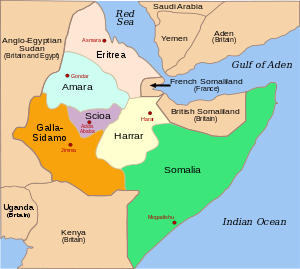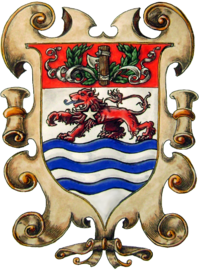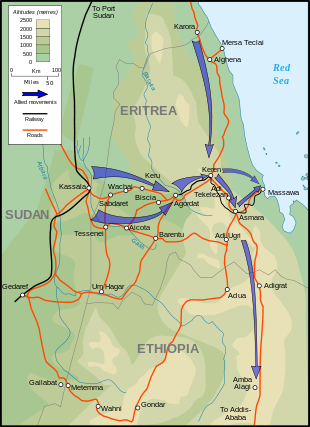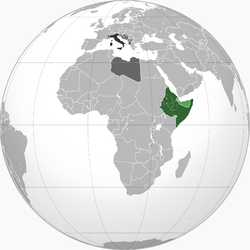Italian East Africa
|
|||||||||||||||||||||||||||||||||||||

Italian East Africa (Italian: Africa Orientale Italiana, or AOI) was a short-lived (1936-1941) Italian colony in Africa consisting of Ethiopia (recently occupied after the Second Italo-Abyssinian War) and the established colonies of Italian Somaliland and Italian Eritrea held in the name of Victor Emmanuel III of the Kingdom of Italy. In August 1940, British Somaliland was conquered and annexed to Italian East Africa.
Contents |
Territory
In 1936, Italian East Africa covered Eritrea, the just conquered Ethiopia and the former Italian Somaliland. The colony was divided into six provinces: Italian Eritrea and Italian Somaliland, plus four provinces of Ethiopia (Amhara, Galla-Sidamo, Scioa, Harar) each run by an Italian governor. Each governor was answerable to the Italian viceroy, who represented the Emperor Victor Emmanuel III.
Italian East Africa briefly enlarged in 1940, as Italian forces conquered British Somaliland, thereby creating a single Somali provincial entity within Italian control, though this and the colony was broken apart one year later as Italian East Africa was occupied by British forces.
In the course of the British-led East African Campaign (June 1940-November 1941), Italian East Africa was conquered and dismembered. The other Italian colony in Africa was Italian North Africa (Africa Settentrionale Italiana, or ASI).
History

The dominion was formed in 1936 during Italian Fascist dictator Benito Mussolini's government in Italy with the defeat of Haile Selassie's Ethiopia in the Second Italo-Abyssinian War.
Rule in Italian East Africa was harsh for the native peoples, especially towards Ethiopians as Fascist policy sought to integrate their culture into the Italian Empire. Eritreans integrated very well and even in some way most Somalians. But Ethiopians opposed strongly: in February 1937, following an assassination attempt on Italian East Africa's Viceroy Rodolfo Graziani, Graziani ordered Italian soldiers to raid the famous Ethiopian monastery Debre Libanos where the would-be assassins had briefly taken refuge and had the monks and nuns in the monastery executed.[1] Afterwards, Italian soldiers destroyed native settlements in Addis Ababa, which resulted in hundreds of Ethiopians being killed and their homes left burned to the ground.[1][2]
Fascist colonial policy in the AOI had a divide and conquer characteristic. In order to weaken the Orthodox Christian Amhara people who had run Ethiopia in the past, territory claimed by Eritrean Tigray-Tigrinyas and Somalis was given to the provinces of Eritrea and Somalia.[1], even as a reward for the Eritrean Ascari's help during the Ethiopia's conquest. Reconstruction efforts after the war in 1936, were partially focused on benefiting the Muslim peoples in the AOI at the expense of the Amhara to strengthen support by Muslims for the Italian colony.[1]
Italy's Fascist regime encouraged Italian peasants to colonize the AOI by creating agriculture and small industries there.[1] However few Italians came to the colony, most to Eritrea. By 1940 only 3200 farmers had arrived to Ethiopia, less than ten percent of the Fascist regime's goal.[3]
Continued insurgency by native Ethiopians, lack of resources, rough terrain, and uncertainty of political and military conditions discouraged development and settlement in the countryside[3] But Italian Eritrea enjoyed a huge development, supported by nearly 80,000 Italian colonists.[4].
The colony proved to be highly expensive to maintain, the AOI's budget in 1936-37 requested from Italy 19.136 billion lire to create the necessary infrastructure for the colony.[1] At the time Italy's entire revenue that year was only 18.581 billion lire.[1]
Anyway the Italians did huge and expensive infrastructures, that drained the Italian economy but reduced in those years the unemployment in the Kingdom of Italy. They did 18,794 km (11,678 mi) of new roads asphaltated: in 1940 Addis Ababa was connected by state-of-the-art roads to Asmara and Mogadishu.
Furthermore, 900 km (559 mi) of railways were reconstructed or initiated (like the railway between Addis Abeba and Assab), dams and hydroelectric plants were built, and many public and private companies were established in the underdeveloped country. The most important were: "Compagnie per il cotone d'Etiopia" (Cotton industry); "Compagnia etiopica del latte e derivati" (Milk industry); "Cementerie d'Etiopia" (Cement industry); "Compagnia etiopica mineraria" (Minerals industry); "Imprese elettriche d'Etiopia" (Electricity industry); "Compagnia etiopica degli esplosivi" (Armament industry); "Industria per la birra dell'AOI" (Beer industry); "Trasporti automobilistici (Citao)" (Mechanic & Transport industry).
There was an urbanistic project for the enlargement of Addis Ababa, in order to become the state-of-the-art capital of the Africa Orientale italiana, but these architectural plans -like all the other developments- were stopped by World War II.[5]
In June 1940, at the beginning of Italy's involvement in World War II, the AOI potentially constituted a dangerous menace to British interests in Africa. From one perspective, a successful Italian attack from the colony through the Sudan and the establishment of a connection to Italian-held Libya would have isolated vital British positions in Egypt and the Suez Canal.
However, from a different perspective, the colony itself was isolated from Italy and surrounded by British forces in the Sudan, Kenya, and British Somaliland. British forces in Aden could provide critical air and naval support against Italian naval forces operating in the Red Sea. Italian maritime transport was cut off by the British at the Suez Canal. What supplies did arrive in the AOI were generally from the air and in small quantities.
In 1940, the adjacent protectorate of British Somaliland was occupied by Italian forces and absorbed into Italian East Africa. The conquest was the only victory of Italy without reinforcement from German troops during World War II against the Allies. This occupation lasted around one year.

At the beginning of the East African Campaign, the Italian troops amounted to 291,000 men including native troops. Training of the native troops was poor, the Italian garrisons were too spread out, due to the extremely poor state of most roads, and were essentially reduced to a static role without enough ammunitions and oil reserves (which allowed the Allies to liberate AOI in 1941).
On March 27, 1941 the stronghold of Keren was captured by the British troops after a strenuous defence from general Orlando Lorenzini in the bloody Battle of Keren. After the surrender of Massaua (April 8), Eritrea was lost for Italy.
The war was lost on May 1941, when the last stand on Amba Alagi under Viceroy Amedeo di Savoia, Duke of Aosta, at Amba Alagi ended honourably in face of overwhelming Allied troops. On November 28 of the same year, general Guglielmo Nasi and the last Italian occupants of Gondar surrendered.
Many Italians fought a guerrilla war in the "Africa Orientale Italiana", after the surrender at Gondar of the last regular Italian forces in November 1941. Indeed from November 1941 to September 1943 there was an Italian guerrilla force made up of 7000 Italians who had not accepted surrender to the Allies.
They were waiting for the possible arrival of the Italo-German army of Rommel from Egypt and the Mediterranean (called in 1942 by Mussolini "the Italian Mare Nostrum"), but after the Battle of El Alamein the momentum of this resistance slowly faded away.
Governor-Generals of Africa Orientale Italiana
The following are the Governor-Generals (called even "Viceroys") of Italian East Africa, from 1936 to 1941:
| Term | Incumbent | Emperor |
|---|---|---|
| Italian East Africa (Africa Orientale Italiana) | ||
| 9 May 1936 to 11 June 1936 | Pietro Badoglio, duca di Addis Ababa, Viceroy and Governor-General | Victor Emmanuel III |
| 11 June 1936 to 21 December 1937 | Rodolfo Graziani, marchese di Neghelli, Viceroy and Governor-General | Victor Emmanuel III |
| 21 December 1937 to 19 May 1941 | Amedeo di Savoia, duca d'Aosta, Viceroy and Governor-General | Victor Emmanuel III |
| 23 May 1941 to 6 July 1941 | Pietro Gazzera, acting Viceroy and Governor-General | Victor Emmanuel III |
| 6 July 1941 to 27 November 1941 | Guglielmo Nasi, acting Viceroy and Governor-General | Victor Emmanuel III |
Notes
Bibliography
- Antonicelli, Franco (1961) Trent'anni di storia italiana 1915 - 1945, Saggi series 295, Torino : Einaudi, 387 p. [in Italian]
- Cannistraro, Philip V. (1982) Historical Dictionary of Fascist Italy, Westport, Conn.; London : Greenwood Press, ISBN 0-313-21317-8
- Del Boca, Angelo (1986) Italiani in Africa Orientale: La caduta dell'Impero, Biblioteca universale Laterza 186, Roma : Laterza, ISBN 88-420-2810-X [in Italian]
- Mockler, Anthony (1984) Haile Selassie's War: The Italian-Ethiopian Campaign, 1935-1941, New York : Random House, ISBN 0-394-54222-3
- Sarti, Roland (1974) The Ax Within: Italian fascism in action, New York : New Viewpoints, ISBN 0-531-06498-0
- Mauri, Arnaldo (1967), Il mercato del credito in Etiopia, Milano, Giuffrè, pp. XVI, 504 [in Italian].
See also
- Colonial heads of Italian East Africa
- Italian Governors of Addis Ababa
- Italian Governors of Amhara
- Italian Governors of Galla-Sidamo
- Italian Governors of Harar
- Italian Governors of Scioa
- Dubats
- Political history of Eastern Africa
- Italian guerrilla war in Ethiopia
- Italian Africa Police
- Italian East African lira
- Augusto Turati
External links
- Italian East African Armed Forces, 10 June 1940
- 1940 Colonial Brigade, 10 June 1940
- Italian East Africa Air Command, 10 June 1940
- Ascari: I Leoni di Eritrea/Ascari: The Eritrean Lions. Second Italo-abyssinian war. Eritrea colonial history, Eritrean ascari pictures/photos galleries and videos, historical atlas...
|
|||||||||||||||||||||||||||
|
||||||||||||||
.svg.png)
